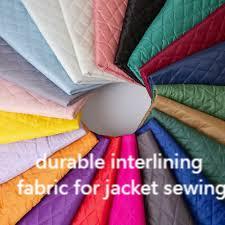-
Feed de notícias
- EXPLORAR
-
Páginas
-
Grupos
-
Blogs
Interlining Development Strategies By Interlining-Factory For Sustainable, Scalable Manufacturing

The hidden support layer is pivotal in garment performance: choosing the right Interlining during prototyping prevents fit issues and maintains silhouette integrity, and integrating the correct Interlining early reduces production waste, improves pressing results, and streamlines downstream assembly. This article explores material choices, bonding methods, testing protocols, production workflows, and sustainable approaches that turn a thin support layer into a decisive advantage for designers and manufacturers.
Materials and Substrate Selection
Selecting the substrate begins with the face fabric. Woven backings offer dimensional stability for tailored outerwear, knitted variants provide stretch recovery for active garments, and nonwoven options deliver even thickness and cost-effective performance for mass production. Fiber content—natural, synthetic, or blended—determines ironing windows, adhesive compatibility, and laundering behavior. Carefully matching substrate flexibility to the face textile prevents show-through, reduces stiffness, and preserves the desired hand and drape.
Bonding Methods and Process Control
Adhesive strategies strongly affect final performance. Options include hot-melt coatings, thermal lamination, stitch-through reinforcements, and ultrasonic bonding. Each requires precise control of temperature, pressure, and dwell time on pressing equipment. Too much heat can discolor or distort a face fabric; too little yields weak adhesion and delamination. Inline sensors, calibrated press cycles, and documented process windows help technicians replicate prototype results reliably at production speeds.
Balancing Drape, Hand, and Structure
Design teams must reconcile aesthetic aims with functional needs. Heavier support layers deliver crisp collars, structured lapels, and long-lasting hems, while lighter constructs preserve movement and softness in flowing garments. Graded reinforcement—applying heavier substrate in collars and lighter weight across larger panels—creates refined silhouettes without adding unnecessary bulk. Measuring bend stiffness, compressibility, and thickness variability predicts how panels will hang and informs optimal pattern placement.
Testing, Quality Assurance, and Production Readiness
Rigorous testing eliminates surprises after scale-up. Important assays include peel and shear adhesion, repeated wash cycles, thermal aging, and dimensional stability under pressing. Inline thickness gauges and bond-coverage imaging catch deviations early. Suppliers offering standardized test reports and production sample lots accelerate vendor qualification. Maintain acceptance criteria in tech packs—thickness tolerances, adhesion thresholds, and pressing windows—so line teams have clear pass/fail metrics during ramp-up.
Integration With Manufacturing Workflows
Early specification prevents late-stage substitution and costly rework. Incorporate reinforcement codes into cutting markers and pre-kit the correct substrate with pattern pieces. Use registered laminates and pre-applied adhesives where possible to reduce on-line complexity. Train press operators on the specific temperature and dwell settings for each fabric-substrate pairing, and document those settings in an accessible production dossier so results remain consistent across shifts and sites.
Sustainability and Lifecycle Considerations
Environmental impact increasingly shapes sourcing decisions. Recycled fiber backings, water-based adhesives, and lower-energy bonding equipment reduce the carbon footprint while maintaining performance. Conduct lifecycle assessments to weigh initial production impacts against extended garment longevity—durable reinforcement can reduce returns and replacements, improving overall sustainability. Design for disassembly by choosing adhesives and backings compatible with recycling streams to support circular economy goals.
Supplier Collaboration and Risk Mitigation
Price alone should not drive supplier choice. Evaluate partners for batch consistency, transparent technical data, and the ability to support scale-ups. Joint development programs reduce risk during production ramp-up, and maintaining qualified second sources mitigates supply disruptions. Include critical tolerances—thickness variance, adhesion strength, thermal processing—in contracts to ensure continuity under variable demand.
Practical Guidance for Product Teams
Begin with a clear functional brief—whether reinforcement, insulation, opacity, or thermal stability—and trial candidate laminates with the actual face fabric through representative care cycles. Require batch test certificates and set acceptable tolerance bands for thickness and adhesion. Use graded stabilization in complex patterns to position support where it matters most, and always document pressing parameters so production teams can reproduce results reliably.
Conclusion and Resources
The discrete support layer beneath outer fabrics plays an outsized role in fit, finish, and durability. Through considered material selection, precise bonding, thorough testing, and early collaboration across design and manufacturing, teams can convert this component into a measurable competitive edge. For deeper technical guidance and application examples, visit https://www.interlining-factory.com/news/what-is-interlining-types-applications-and-more.html
- Art
- Causes
- Crafts
- Dance
- Drinks
- Film
- Fitness
- Food
- Jogos
- Gardening
- Health
- Início
- Literature
- Music
- Networking
- Outro
- Party
- Religion
- Shopping
- Sports
- Theater
- Wellness
